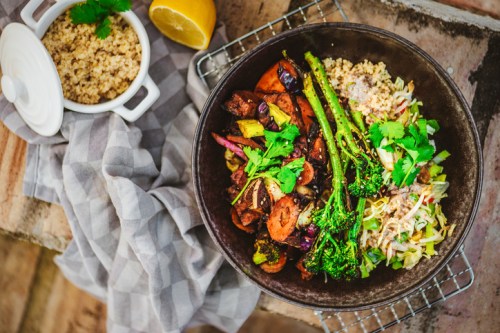Our editors independently select these products. Making a purchase through our links may earn Well+Good a commission
Why RDs Are Infatuated With Fonio, the Protein-Rich Grain That’s Great for Skin, Sleep, and Gut Health
Here, we chat with a dietitian and a chef about fonio, including how to cook the fonio grain and fonio benefits for health.

You’ve eaten your way through endless farro salads, love every style of barley soup, and cannot stop finding new uses for quinoa. But now, you’re looking for another grain to add to the rotation. Enter fonio, the gluten-free West African grain packed with nutrients and delicious flavor. Chefs love it just as much as health experts: Fonio is easy to make and super versatile, plus it’s packed with plant-based protein, and touts major benefits for skin, sleep, digestion, and more.
Experts in This Article
registered dietitian and nationally-recognized food, nutrition, and wellness expert with a private nutrition counseling practice
While fonio hasn’t quite gained the same mainstream attention in America that oats or quinoa have, it is by no means a new ingredient. In fact, farmers in West Africa have been cultivating and harvesting fonio for thousands of years. The hardiness of the crop—it can survive in extremely arid conditions—combined with its nutrient density and endless culinary uses has made it an integral ingredient in many West African recipes. Effectively a tiny form of millet, fonio has a nutty, earthy taste and bears a striking resemblance to cornmeal (even when cooked). And like cornmeal, it serves as a great base for soaking up hearty stews and spicy sauces, which are other delicious mainstays of West African cuisine.
Here, we chatted with professional chefs and nutrition experts to learn more about the history of fonio, its health benefits, and how you might consider incorporating it into meals.
Fonio has been a prized crop for many centuries
“Fonio is often referred to as ‘the seed of the universe’ or ‘the grain at the root of all existence’ to the Dogon people of Mali,” says Pierre Thiam, chef, cookbook author, and co-founder and president of African food company Yolélé. Yolélé, founded in 2017, was created with the key purpose of creating economic opportunity for small farming communities in Africa by supporting their farming systems and their most prominent crop: fonio. “This grain has been a prized source of sustainable nutrition in West Africa for thousands of years, and has also been cultivated as a badge of pride,” Thiam adds.
As Thiam notes in The Fonio Cookbook, “Whenever fonio is served, it’s another sign of honoring the guest, as fonio is also nicknamed ‘ñamu buur,’ or ‘food for royalty.’ Fonio is so revered in African cultures, in fact, that mothers are known to put fonio in children’s backpacks before sending them off to school, especially during exam season.” Fonio has even been found entombed in Ancient Egyptian pyramids, Thiam adds.
Fonio benefits for health
1. The fonio grain is great for your cardiovascular system.
“Fonio is a naturally gluten-free grain, plus it’s a whole grain, meaning it has all the parts of the grain intact,” explains Samantha Cassetty, MS, RDN. “Making the switch from refined grains to whole grains, such as fonio, is associated with a lower risk of stroke, type 2 diabetes, and heart disease, as well as better weight management,” Cassetty says. This is because it’s a good source of fiber—a half-cup serving provides four percent of the daily value, which is more than both millet and sorghum—along with plant-based protein.
2. It helps your skin and hair stay healthy.
Fonio is also rich in iron, zinc, B vitamins, and the sulfur-containing amino acids methionine and cysteine. These amino acids are responsible for the growth and repair of body tissues, skin elasticity, hair and nail health, and protein synthesis.
3. It boosts your sleep and your gut microbiome.
In addition, Cassetty notes that fonio supplies meaningful levels of magnesium, which is a nutrient known to benefit your sleep cycle and something many Americans are deficient in. “It’s a strong source of gut-boosting antioxidants, too,” she adds. “Particularly a class of antioxidants known as phenols that feed your gut microbes.”
4. Fonio can help keep blood sugars stable.
“And because the fonio grain is a complex carbohydrate—meaning it is digested more slowly than sugars or refined grains—it can help sustain the body with energy throughout the day,” notes Thiam. “It is low-glycemic, meaning is fonio a good alternative to white rice, pasta, or couscous for those watching their blood sugar levels, like diabetics.”
5. It’s a good source of essential amino acids for those eating plant-based.
“For people who are strictly eating plant proteins, fonio can help meet the needs for the essential amino acids we need to get through food,” she adds. In fact, fonio can meet up to 10 percent of an adult’s requirements for almost all essential amino acids, the sole exception being lysine.
How to cook fonio
Start by checking out Yolélé, which offers a range of easy-to-cook (and eat) fonio options, including fonio-based Dakar Curry and other forms of fonio pilaf, chips made from the fonio grain, fonio flour, and traditional West African Jollof.
The preparation process for the plain fonio grain is super simple. If you’re using the stovetop, coat a half cup cup fonio with one tablespoon oil and toss well. Then add one cup water and bring to a boil. Add a pinch of salt, stir, cover, and turn heat to low for one minute. Finally, remove from heat and keep covered for four minutes, then fluff with a fork.
You can also microwave fonio by stirring a tablespoon of oil into a half cup of fonio, then adding a pinch of salt and a cup of water before covering the mixture with a fitted lid and microwaving on high for two minutes. Let it sit to absorb all remaining liquid for another two minutes, then fluff with a fork.
Thiam recommends using fonio in everything from hot cereal and breakfast bowls with a runny egg to bolstering a vegan or blended burger to replacing traditional flours in a brownie, cookie, or other baked good. Ultimately, your imagination is the limit when it comes to cooking with fonio, and considering the health benefits, this is one opportunity to truly let your imagination run wild. After all, it’s virtually impossible to go wrong.
Oh hi! You look like someone who loves free workouts, discounts for cutting-edge wellness brands, and exclusive Well+Good content. Sign up for Well+, our online community of wellness insiders, and unlock your rewards instantly.










